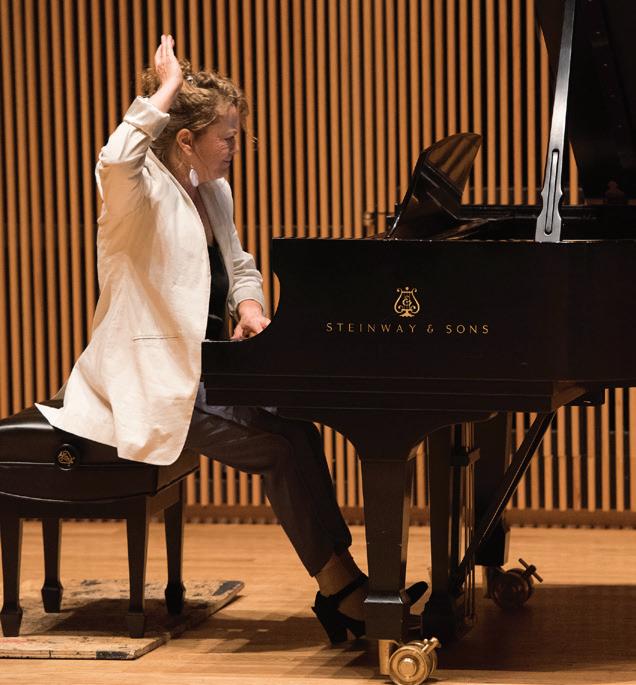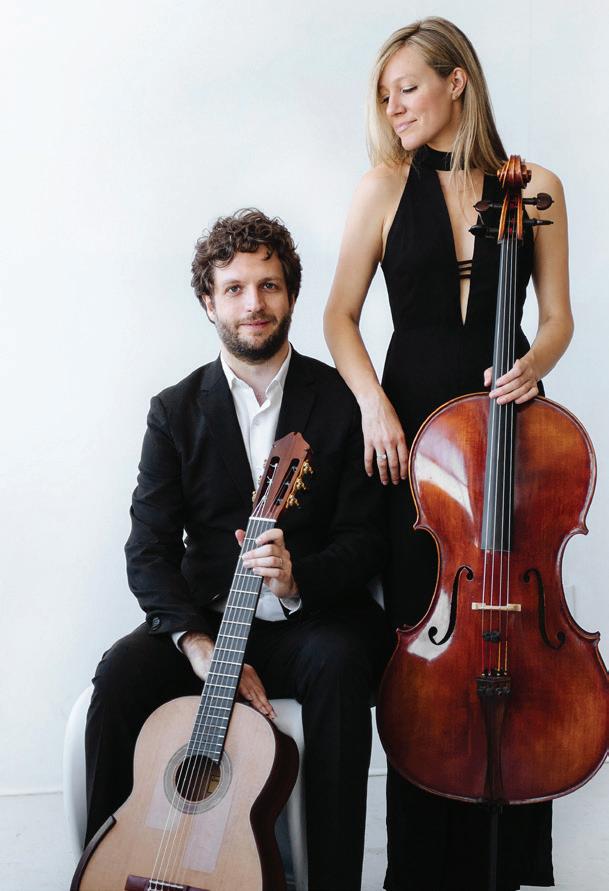24/25 SEASON


24/25 SEASON


Saturday, October 19 | 8pm
Harris Theatre at GMU
Bernstein: “Candide Overture”
Elena Kats-Chernin: “Force Majeure” for piano and orchestra (US Premiere)
Lisa Moore, piano
Copland: Appalachian Spring
Bernstein: 3 Dance Episodes from “On the Town”
Saturday, November 23 | 8pm
Center for the Arts at GMU
Quinn Mason: “She Dreams of Flying” (Regional Premiere)
Beethoven: Piano Concerto No. 4
Jeremy Denk, piano
Rachmaninoff: Symphonic Dances


Saturday, December 21 & Sunday, December 22 | 4pm Center for the Arts at GMU
Tchaikovsky: The Nutcracker with the Fairfax Ballet and New York City Ballet soloists
Visit www.FairfaxSymphony.org
Saturday, February 8 | 8pm
Harris Theatre at GMU
Maurice Jarre: Dr. Zhivago orchestral suite
Clarice Assad: “Anahata” (Regional Premiere)
Boyd Meets Girl, guitar and cello
Mascagni: Intermezzo from Cavalleria Rusticana
Puccini: Intermezzo from Suor Angelica
Mahler: “Love letter to Alma” Adagietto from Symphony No. 5
Bizet: Selections from Carmen Suites


Saturday, March 8 | 8pm
Center for the Arts at GMU
Dvořák: Three Slavonic Dances from Op. 72
Elgar: Cello Concerto
Sergey Antonov, cello
Mussorgsky/Ravel: Pictures at an Exhibition
Saturday, May 31 | 8pm
Center for the Arts at GMU
Elgar: Introduction and Allegro for Strings
Leshnoff: Concertante for 2 violins (Regional Premiere)
Chee-Yun and Kit Zimmerman, violin
Shostakovich: Symphony No. 10






Christopher Zimmerman, music director and conductor
Saturday, March 9, 2024 at 8pm
Center for the Arts at George Mason University
Christopher Zimmerman, music director and conductor
Saturday, October 19, 2024 at 8 pm
Harris Theatre at George Mason University
MALEK JANDALI (1972-)
Selected Movements from Symphony No. 6 , “The Desert Rose”
“Candide Overture”
II.“Praise”
V.“Ardah”
VII.“Fete”
(1918-1990)
ELENA KATS-CHERNIN (b. 1957)
“Force Majeure” for Piano and Orchestra (U.S. Premiere)
MALEK JANDALI
Lisa Moore, piano
Concerto for Clarinet and Orchestra (WORLD PREMIERE PERFORMANCE)
I.Andantino misterioso
II.Nocturne
Intermission
III.Allegro moderato
AARON COPLAND (1900-1990)
Anthony McGill, clarinet
Suite from “Appalachian Spring”
—Intermission—
(1918-1990)
Three Dance Episodes from “On the Town”
LUDWIG VAN BEETHOVEN (1770-1827)
Symphony No.3 in E flat major “Eroica”, op.55
I. The Great Lover
I.Allegro con brio
II. Lonely Town (Pas de deux)
III. Times Square: 1944
II.Marcia funebre—adagio assai
III.Scherzo—allegro vivace
IV.Finale—allegro molto
The FSO’s 2024/25 Season is made possible with generous support from







Composer: born December 25, 1972, Waldbröl, West Germany
Composer: born August 24, 1918, Lawrence, MA; died October 14, 1990, New York City
The desert rose, with its intricate crystalline petal clusters, forms over millennia through the interaction of minerals, sand, and water in regions such as Qatar—a land of desert and sea. This “architectural” wonder of nature inspired the design of Jean Nouvel’s masterpiece, the National Museum of Qatar, a stunning structure of interlocking discs that tells the story of Qatar from the natural history of its origins through its cultural developments to the cutting-edge technologies of today.
Work composed: 1956
World premiere: Candide premiered at New York’s Martin Beck Theater on December 1, 1956.
In 1954, Leonard Bernstein teamed up with playwright Lillian Hellman and lyricist Richard Wilbur to adapt Voltaire’s 18th-century satire, Candide, the story of a naïve innocent who believes wholeheartedly in the teachings of his mentor, Dr. Pangloss, who proclaims, “This is the best of all possible worlds.” Determined to prove his teacher right, Candide embarks on a worldwide journey of discovery with Pangloss and Candide’s sweetheart, Conegonde. Together they visit Lisbon, Paris, Buenos Aires, and the mythical land of El Dorado, where they witness the terrible realities of life in the forms of crime, atrocity, and suffering. Utterly disillusioned, Candide returns to Venice with Conegonde, stripped of his idealism.
Springing from the idea that architecture is frozen music, Malek Jandali’s Symphony No. 6 takes its inspiration from both “desert roses,” transforming them into a consummate orchestral work that preserves and extends the rich heritage of the region. The Desert Rose Symphony depicts their complexity and contrasts in form and scale, juxtaposing the traditional and the modern—rapid progress intertwined with the arid golden sand dunes and the abundance of the sea. The nine-movement symphony also takes inspiration from the nine-point serrated line in the flag of Qatar indicating the ninth member of the “Reconciled Emirates” of the Persian Gulf in the wake of concluding the Qatari-British treaty in 1916. The white color reflects the internationally recognized symbol of peace. This work is commissioned by Her Excellency Sheikha Al-Mayassa bint Hamad bin Khalifa Al Thani, chairperson of Qatar Museums.
Bernstein’s high-voltage treatment of Voltaire amounts to a brilliant and sophisticated parody of opera itself. However, in its original version, which premiered at New York’s Martin Beck Theater on December 1, 1956, Candide failed to appeal to either audiences or critics. In 1973, Bernstein worked with Hugh Wheeler on a revised book with some added lyrics by Steven Sondheim. This revival version quickly became a hit, both on Broadway and at the New York City Opera.
Like its inspirations, Symphony No. 6 harbors an elaborate interlocking structure. Bookmarked in A-flat major, in which key the first and last movements end, the Symphony comprises three interlaced musical forms—a symphonic suite and two symphonies. One is a Qatari symphonic suite based on traditional folk music and dances using the principal of contrast: Movements II, III, V and VII. Second is a traditional “old-fashioned” symphony of four Movements I, IV, VI and IX. The third combines the first two “symphonies” with Movement VIII, which brings about the grandiose conclusion of the Desert Rose Symphony.
The music of the Overture captures the frenzied hither-and-thither action of the story, with its relentless travel and equally relentless optimism. Candide’s straightforward, simple character emerges in fresh, sparkling orchestral colors and sunny harmonies.
The Desert Rose Symphony amazes on so many levels, just like its models. Driving rhythmic ostinatos contrast with poetic beauty, old interlocks with new, Qatari folk with Western classical, natural with manmade. Through it all runs the voice of hope for peace and unity.
The symphony was recorded by the ORF Vienna Radio Symphony Orchestra, led by Marin Alsop at the ORF-Funkhaus Wien, on May 15, 2021, just days after its completion. This collaboration between Alsop and Jandali stemmed from Alsop’s commissioning of The Silent Ocean for her contemporary festival in Baltimore after being impressed by the composer’s Syrian Symphony. Says Alsop, “I don’t know of another composer who so successfully weaves in the Arabic, particularly the folk elements... and by bringing that into the symphonic
Composer: born November 4, 1957, Tashkent, Uzbekistan (USSR)
Work composed: 2022. Commissioned by pianist Lisa Moore
World premiere: Roger Benedict led the Sydney Symphony Orchestra Fellows and Conservatorium students with pianist Lisa Moore at Verbrugghen Hall in Sydney, Australia, on November 13, 2022.
One of Australia’s leading composers, Elena Kats-Chernin has created works in nearly every genre.
Through her prolific catalogue of works for theater, ballet, orchestra, and chamber ensemble, Kats-Chernin’s music has achieved a global audience. Her vivid style communicates a mixture of lightheartedness and heavy melancholy, combining strong rhythmic figures with elements of cabaret, tango, ragtime, and klezmer.
Born in 1957 in Uzbekistan, then part of the Soviet Union, Kats-Chernin received training at the Gnessin Musical College before immigrating to Australia in 1975. Her music was heard at the 2000 Sydney Olympic Games, and has been featured in many film and television scores.
Kats-Chernin and pianist Lisa Moore are long-time collaborators, and each is very familiar with the other’s style and musical strengths. “Lisa doesn’t do anything by halves,” Kats-Chernin remarked in a 2022 radio interview for the Australian Broadcasting Corporation. “So I said, ‘If it’s fast, very fast, if it’s loud, very loud.’ That’s what I wanted to write. But where it’s soft and lyrical and atmospheric and elusive, I knew that would be just right for her as well.”
Kats-Chernin writes, “The initial compositional impetus of this concerto coincided with creating an orchestra score for the silent film Varieté for German TV Channel ZDF/arte. I found myself watching and “inhaling” the scenes of the world of trapeze artists at the Showgrounds, working and living through all kinds of emotions – both highs and lows. The circus atmosphere, along with some darker undertones, subconsciously flowed into the piano concerto.
“To me, [the term ‘force majeure’] means force of nature,” Kats-Chernin continues. “Lisa suggested this title. To me, she is the force of nature, and this music is forceful, full-on.
“The four movements of Force Majeure are as follows:
1) Rotor has at its base the rhythmic, motoric and harmonic drive. It’s a movement of high pulsating energy, is a real workout for Lisa, and has a glimpse of the occasional Bach reference.
2) Broken Barcarolle is trance-like, mysteriously atmospheric, elusive at times. There is emphasis on harp and plucked sounds, delicate vibraphone and an occasional gong. There are 4 main harmonic sections, with a scale-like melody appearing in horn and other brass at certain point, just before the harmony makes a shift. There are hints of Debussy here and there.
3) Twisted Rag is an edgy, “in your face” dance, ending with a kind of a Jahrmarkt Waltz after a slowish solo piano moment.
4) Czardas Noir. I have always liked czardas [Hungarian dances]. This finale starts, as often with a czardas, with a slow unfolding of accented materials. There are more heavy, low registers used in this movement. While it is in 4/4, an occasional 3/4 throws it off balance. Many semiquaver passages are being passed around between soloist and ensemble. Towards the end some of the first movement ‘Bachian’ chord progressions return.”
Composer: born November 14, 1900, Brooklyn, NY; died December 2, 1990, North Tarrytown, NY
Work composed: 1943-4. Copland won a Pulitzer Prize for the ballet score in 1945. Copland conducted the premiere of the ballet at the Library of Congress in Washington, D.C. on October 30, 1944, the birthday of arts patron Elizabeth Sprague Coolidge, to celebrate 25 years of her musical philanthropy.
World premiere: Artur Rodziński premiered the orchestral suite with the New York Philharmonic on October 4, 1945.
Shortly before the debut of Ballet for Martha, Aaron Copland’s working title for the ballet Martha Graham had commissioned from him, the choreographer announced she had decided on the name Appalachian Spring. Graham, who borrowed the words from Hart Crane’s poem, The Dance, admitted she had chosen it simply because she liked the sound of the words together, and that it had no connection with either the location or scenario of the ballet. “Over and over again,” Copland recalled in 1981, “people come up to me after seeing the ballet on stage and say, ‘Mr. Copland, when I see that ballet and when I hear your music I can just see the Appalachians and I just feel spring.’ Well, I’m willing if they are!”
In Appalachian Spring, Copland’s affinity for folk melodies and idioms reaches its zenith. The Shaker hymn “Simple Gifts,” which Copland discovered in a 1940
book on Shaker culture, and the celebratory variations of its melody, form the climax of Appalachian Spring. When Copland arranged Appalachian Spring as an orchestral suite, he emphasized the song’s centrality by cutting several episodes from the ballet and changing the order of the variations. As scholar William Brooks notes, “In this context the Shaker melody came to serve as a kind of paradigm for the simplicity and authenticity of frontier America: mythical music for a mythical past.” In similar fashion Copland’s music, particularly Appalachian Spring, became the paradigm for the “American” sound of the mid-20th century.
Copland explained his musical conception: “When I wrote Appalachian Spring, I was thinking primarily about Martha and her unique choreographic style, which I knew well. Nobody else seems quite like Martha: she’s so proud, so very much herself. And she’s unquestionably very American: there something prim and restrained, simple yet strong about her, which one tends to think of as American.”
Edwin Denby, a noted dance critic, provided program notes for the premiere of the Appalachian Spring orchestral suite in 1945: “A pioneer celebration in spring around a newly-built farmhouse in the Pennsylvania hills in the early part of the last century. The bride-to-be and the young farmer-husband enact the emotions, joyful and apprehensive, that their new domestic partnership invites. An older neighbor suggests now and then the rocky confidence of experience. A revivalist and his followers remind the new householders of the strange and terrible aspects of human fate. At the end the couple are left quiet and strong in their new house.”
Work composed: Bernstein spent the months between June and December 1944 composing On the Town. The following year he transcribed three dance episodes from the show for concert band.
World premiere: On the Town premiered on December 28, 1944, at the Adelphi Theatre in New York City. Bernstein conducted the Three Dance Episodes with the San Francisco Symphony on February 3, 1946, at the Civic Auditorium.
On the Town, a collaboration of composer Leonard Bernstein, director/ choreographer Jerome Robbins and writers Betty Comden and Adolph Green, was the perfect anodyne for a nation weary of war. Written during the last year of World War II, it tells the simple story of three sailors and their adventures while on a 24-hour leave in New York City. “We wanted [the sailors] to possess the quality and attitudes of the servicemen we had seen coming into the city
for the first time, and at least touch on the frantic search for gaiety and love, and the terrific pressure of time that war brings,” said Comden.
Dance is central to the show, both as a means of forwarding the narrative, and also as an end in itself. Bernstein explained, “It seems only natural that dance should play a leading role in the show On the Town, since the idea of writing it arose from the success of the ballet Fancy Free. I believe this is the first Broadway show ever to have as many as seven or eight dance episodes in the space of two acts … that these are, in their way, symphonic pieces rarely occurs to the audience actually attending the show, so well- integrated are all the elements.”
Not long after On the Town’s Broadway premiere, Bernstein arranged three of its dance interludes for concert band. In Dance of the Great Lover, Gabey, one of the sailors (played in the 1949 film by Gene Kelly), falls in love with Miss Turnstiles, whose poster he sees in the subway. In a dream Gabey imagines meeting and wooing her. The music captures the hustle and bustle of New York traffic and Gabey’s hopeful optimism. The Pas de Deux features one of Bernstein’s indelible tunes, “Lonely Town.” Gabey watches a callous sailor entice a young high school girl into a romantic tryst in Central Park and then abandon her. The final episode, Times Square Ballet, captures the sailors’ frantic attempts to see everything in New York “in just one day,” to the tune of the show’s most recognizable number, “New York, New York, It’s A Helluva Town.”
© Elizabeth Schwartz






Hailed for his “trademark brilliance, penetrating sound and rich character” (New York Times), clarinetist Anthony McGill enjoys a dynamic international solo and chamber music career and is principal clarinet of the New York Philharmonic — the first African-American principal player in the organization’s history. He is the recipient of the 2020 Avery Fisher Prize, one of classical music’s most significant awards.
McGill appears as a soloist with top orchestras, including the New York and Los Angeles Philharmonics, the Metropolitan Opera, and the Baltimore, Boston, Chicago, and Detroit Symphony Orchestras. He performed alongside Itzhak Perlman, Yo-Yo Ma, and Gabriela Montero at the inauguration of President Barack Obama, premiering a piece by John Williams. As a chamber musician, McGill is a collaborator of the Brentano, Daedalus, Guarneri, JACK, Miró, Pacifica, Shanghai, Takács, and Tokyo Quartets, and performs with leading artists including Emanuel Ax, Inon Barnatan, Gloria Chien, Yefim Bronfman, Gil Shaham, Midori, Mitsuko Uchida, and Lang Lang.
He serves on the faculty of The Juilliard School and is the Artistic Director for Juilliard’s Music Advancement Program. He holds the William R. and Hyunah Yu Brody Distinguished Chair at the Curtis Institute of Music.
In 2020, McGill’s #TakeTwoKnees campaign protesting the death of George Floyd and historic racial injustice went viral. In 2023, he partnered with Bryan Stevenson and the Equal Justice Initiative to organize a classical music industry convening at EJI’s Legacy Museum in Montgomery, Alabama, in which leaders and artists in classical music examined America’s history of racial inequality and how this legacy continues to impact their work. He is a Backun Artist and performs exclusively on Backun Clarinets.
Learn more at www.anthonymcgill.com
New York-based Australian musician Lisa Moore is a multifaceted pianist, recording artist, and collaborator. Named “la leggenda” by La Repubblica (Italy), The New York Times has singled out her playing for its “life and freshness” and “fragility and tenderness,” The New Yorker describes her as “visionary” and “New York’s queen of the avant-garde piano” while Pitchfork claims “she’s the best kind of contemporary classical musician, one so fearsomely game that she inspires composers to offer her their most wildly unplayable ideas.” Given a special passion for the music of our time, Moore won the silver medal in the 1981 Carnegie Hall International American Music Competition and has since performed hundreds of commissioned works and world premieres—having worked with more than two hundred living composers while residing in the vibrant new music scene of New York City since 1985. Moore has performed throughout the USA, UK, Europe, Australia, and Asia in festivals including Tanglewood, Aspen, Adelaide, Warsaw, Paris, Hong Kong, and Vienna as well as on the world’s great stages: New York’s Carnegie Hall (Stern, Zankel, Weill) and Alice Tully Hall at Lincoln Center, Sydney Opera House, Melbourne Recital Centre, La Scala in Milan, Amsterdam’s Royal Concertgebouw, London’s Royal Albert Hall and Royal Festival Hall, and Vienna’s Musikverein. She has released 12 solo albums and more than 30 collaborative discs. Gramophone writes about her Mad Rush Philip Glass disc: “what becomes abundantly clear is Moore’s highly developed, intuitive, and nuanced approach to this music.” Moore’s album The Stone People was selected as one of the The New York Times Top Classical Albums 2016 and as a Naxos Critics’ Choice 2017. For 16 years (1992–2008) Moore was the founding pianist for the award-winning electro-acoustic sextet Bang On A Can All-Stars. She has performed with leading artists, ensembles, orchestras, and dance companies including Philip Glass, Meredith Monk, Ornette Coleman, Frederic Rzewski, Don Byron, Pamela Z, Thurston Moore, Iva Bittova, Bryce Dessner, London Sinfonietta, Steve Reich Ensemble, New York City Ballet, American Composers Orchestra, and The Chamber Music Society of Lincoln Center. Moore has performed under the orchestral batons of Leonard Bernstein, Pierre Boulez, David Robertson, Roger Benedict, Brett Dean, Brad Lubman, Steven Schick, Benjamin Northey, Richard Mills, Reinbert de Leeuw, Jorge Mester, Leonard Dommett, Dobbs Franks, and Angel Gil-Ordóñez.
Lisa Moore is a Steinway artist. Please visit www.lisamoore.org.


Named Music Director of the Fairfax Symphony Orchestra (FSO) in 2009, Christopher Zimmerman celebrates his 15th season with the FSO. Former Washington Post classical music critic, Anne Midgette, wrote: “the Bernstein was a note-perfect end to a very refreshing evening that spoke well for the programming vision of Zimmerman.” Former Washington Post reporter, Stephen Brookes, commented: “Zimmerman has been injecting adrenalin into this determined ensemble… (and has) made the Fairfax players a serious force to be reckoned with.”
Christopher Zimmerman graduated from Yale with a B.A. in Music and received his Master’s from the University of Michigan. He also studied with Seiji Ozawa and Gunther Schuller at Tanglewood, and at the Pierre Monteux School in Maine with Charles Bruck. Zimmerman served as an apprentice to Andrew Davis and the Toronto Symphony and in Prague, as assistant conductor to Vaclav Neumann and the Czech Philharmonic Orchestra.
Zimmerman’s debut with the Royal Philharmonic Orchestra was followed by engagements with the London Symphony Orchestra and the Royal Liverpool Philharmonic.
Prior to his appointment to the FSO, Christopher Zimmerman was Music Director of the Symphony of Southeast Texas, the Bangor Symphony Orchestra and the City of London Chamber Orchestra. His career has also embraced teaching and working with student orchestras and conductors; in 1993 he joined the conducting faculty at the College-Conservatory of Music in Cincinnati where he was Music Director of their concert orchestra, and in 1999 he was appointed as Fuller Professor of Orchestral Studies at the Hartt School as well as Music Director of the Hartt Symphony.
A champion of contemporary music and commissioning new work, during his leadership with the FSO, Zimmerman has commissioned seven new works and presented 22 premieres. This season, the FSO presents the U.S. premiere piano concerto by composer Elena Kats-Chernin with pianist, Lisa Moore, the Regional premiere of “She Dreams of Flying” by composer Quinn Mason, the Virginia premiere of Clarice Assad’s concerto for Guitar and Cello “Anahata,” and the commission and East Coast premiere by Jonathan Leshnoff “Concertante for Two Violins and Orchestra.” In 2023-24, Zimmerman conducted the World Premiere Clarinet Concerto by Syrian-American composer Malek Jandali with clarinetist, Anthony McGuill, the Regional premiere of Anna Clyne’s “Dance” with cellist Inbal Segev, and the co-commission and Virginia premiere of “Rhapsody in Red, White, and Blue” with pianist Jeffrey Biegel in honor of the 150th Anniversary of Gershwin’s “Rhapsody in Blue.” In 2023, Zimmerman and the FSO presented the U.S. premiere of “Bruromano,” a concerto for guitar, double bass, and string orchestra by Czech composer Sylvie Bodorova featuring renowned guitarist, Jason Vieaux. In 2022, the FSO presented the regional premiere of composer Robert Carl’s “White Heron” and composer Jonathan Leshnoff’s Symphony No. 4 “Heichalos.” The FSO brought “Dances of the Yogurt Maker” by Turkish composer, Erberk Eryilmaz to Virginia for the first time in 2019, along with the 2018 Virginia premiere of Philip Glass’ “Piano Concerto No. 3,” with pianist Simone Dinnerstein, who commissioned the work and for whom it was written. In 2017, the Fairfax Symphony in celebration of its 60th season commissioned “Resolutions” by composer Mark Camphouse in honor of the 275th Anniversary of Fairfax County. In 2016, the FSO presented the regional premiere of Martin Bresnick’s “The Way it Goes.”
Zimmerman has also established four artistic collaborations while leading the FSO—its annual co-presentation with George Mason University’s Center for the Arts featuring renowned artists including acclaimed soprano Renée Fleming, and pianists Jeremy Denk and Simone Dinnerstein, the annual production of Tchaikovsky’s The Nutcracker with the Fairfax Ballet, and a collaboration with Bown-McCauley Dance Company.
Christopher Zimmerman was recognized as the winner of the American Conducting Prize in 2011, an award given for nationwide performances by orchestral conductors, choral conductors, and a host of other categories. Such recognition of his abilities has been born out in appointments to the Music Directorship of the Fargo-Moorhead Symphony (2013-) and Artistic Directorship of the American Youth Philharmonic Orchestras (2014-2017).
The Fairfax Symphony gratefully acknowledges the generosity of the following contributions received within the past twelve months as of May 1, 2024. Thank you for dedicating these vital gifts to the music and education programs we work so passionately to create and share with our community.
The Fairfax Symphony gratefully acknowledges the generosity of the following contributions received within the past twelve months as of October 1, 2024.
Thank you for dedicating these vital gifts to the music and education programs we work so passionately to create and share with our community.
GOVERNMENT ARTSFAIRFAX
GOVERNMENT
ARTSFAIRFAX
City of Fairfax Commission on the Arts
City of Fairfax Commission on the Arts
County of Fairfax
County of Fairfax
National Endowment for the Arts
National Endowment for the Arts
Virginia Commission for the Arts
Virginia Commission for the Arts
Stephen and Mary Preston
Laura and Ervin Walter
Pepe Figueroa, In Memory of the Figueroa Quintet
Donald and Ruth Drees
Robert W. Henry
Frank and Lynn Gayer
Mr. Kurt P. Jaeger
Eric and Joyce Hanson
Eric Moore
Valarie Ney
Mr. and Mrs. Eugene Kaye
Robert W. Henry
Mr. and Mrs. Anthony Kerr
Mr. Kurt P. Jaeger
FOUNDATIONS AND CHARITABLE FUNDS
Anonymous
Anonymous
Paul M. Angell Family Foundation
Paul M. Angell Family Foundation
Charles Delmar Foundation
Charles Delmar Foundation
Nelson J. & Katherine Friant-Post Foundation
Community Foundation of Northern Virginia
Richard & Caroline T.
Gwathemy Memorial Trust
Nelson J. & Katherine Friant-Post Foundation
Richard & Caroline T.
Mary & Daniel Loughran Foundation
Gwathemy Memorial Trust
TD BANK Foundation
The Rea Charitable Trust
Mary & Daniel Loughran Foundation
TD BANK Foundation
CORPORATIONS
The Rea Charitable Trust
Hilton Fairfax
CORPORATIONS
Goodwin Living
John Marshall Bank
McKeever Services
The Mather
Dominion Energy
Hilton Fairfax Goodwin Living McKeever Services
NOVEC
The Mather
Dominion Energy
Priority One Services, Inc.
NOVEC
SYMPHONY SOCIETY CONCERTO CLUB
Priority One Services, Inc.
Transurban
PLATINUM
Mr. and Mrs. Thomas M. Brownell
CONDUCTOR’S CIRCLE
PLATINUM
Pepe Figueroa
Mr. and Mrs. David Black
Joyce L. Hanson
Dr. Mark Head
Mr. and Mrs. Thomas M. Brownell
Martin Poretsky
Martin Poretsky
The Timothy Evan Owens Memorial Chair
Anje Kim
Mr. and Mrs. Eugene Kaye
Dr. and Mrs. Per Kullstam
Steve and Debbie Cohen
Stephen and Mary Preston
Mr. and Mrs. Anthony Kerr
David and Lenka Lundsten
Mr. Sean Foohey
John Lockhart
Anje Kim
John and Jeanette Mason
Dr. and Mrs. Per Kullstam
Mr. and Mrs. Matt Mattice
Eric Moore
The Timothy Evan Owens Memorial Chair
John and Jeanette Mason
Joetta Miller
Steve and Debbie Cohen
Mr. Sean Foohey
In memory of Richard Benedict
John Lockhart
Sherman & Etta Mae Thomas Sherman
Mr. and Mrs. Matt Mattice
Judith Nitsche
Joetta Miller
Dr. and Mrs. Eugene Overton
Linda Vitello
Judith Nitsche
Michael Wendt
Dr. and Mrs. Eugene Overton
Sally and Rucj Uffelman
In memory of Richard Benedict Sherman and Etta Mae Thomas
David and Deborah Winston, In Memory of May Winston
Sandra Lee Stoddard
Linda Vitello
Sherman Sally and Rucj Uffelman
Anonymous
Ms. Esther Beaumont
Anonymous (2)
Nina and David Breen
Ms. Esther Beaumont
Janine and Curt Buser
Nina and David Breen
Mr. and Mrs. Edward Caress
Janine and Curt Buser
Daniel and Carol Graifer
Mr. and Mrs. Edward Caress
Mr. and Mrs. C. David Hartmann
Frank and Carolyn Gayer
Daniel and Carol Graifer
Mr. and Mrs. Glenn A. Hemer
Mr. and Mrs. Glenn A. Hemer
Robert and Maryanne Jones
Ms. Joetta Miller
Robert and Maryanne Jones
David & Lenka Lundsten
Mr. William A. Nerenberg
Ms. Joetta Miller
David and Bridget Ralston
James and Miriam Ross
Mr. William A. Nerenberg
Mr. and Mrs. David Seida
David and Bridget Ralston
James and Miriam Ross
Mr. and Mrs. David Seida
Anonymous
William Bell
Bill and Dorothy Brandel
Anonymous
Dr. Karen Detweiler
William Bell
Donald and Ruth Drees
James and Jane Bangarra
Eric and Joyce Hanson
Mr. and Mrs. James
Bongarra, Jr.
Mrs. and Mrs. C. David Hartmann
Bill and Dorothy Brandel
Dr. Karen Detweiler
Michael Wendt
Mr. and Mrs. James Bongarra, Jr.
David and Deborah
Ms. Pamela Charin
Winston, In Memory of May Winston
Christopher Forsberg
Anthony and Lucy Griffin
SONATA CIRCLE
Christopher Gohrband
Ms. Pamela Charin
Gareth and Tân Habel
Christopher Forsberg
Spencer Howell
Anthony and Lucy Griffin
Mr. and Mrs. Keith Highfill
Christopher Gohrband
Mr. and Mrs. Wade Hinkle
Gareth and Tân Habel
Mr. and Mrs. David J. Lynch
Mr. & Mrs. Eric Hanson
Kolleen Martin
Spencer Howell
Helen Noyes
Mr. and Mrs. Keith Highfill
Mr. Justice Percell
Mr. and Mrs. Wade Hinkle
Ms. C. Carole Richard
Kathleen Schultz
Mr. and Mrs. David J. Lynch
Helen Noyes
Mary Jane Spiro
Mr. Justice Percell
Sandra Lee Stoddard
Ms. C. Carole Richard
Mr. Michael W. Stoltz
Deborah Roudebush
Dr. Jack and Mrs. Jane
Mary Jane Spiro
Underhill
Timothy N. Wade
Mr. Michael W. Stoltz
Roy and Margaret Wagner
Mr. William Walderman
Dr. Jack and Mrs. Jane Underhill
Timothy N. Wade
Roy and Margaret Wagner
Mr. William Walderman
Dr. Charles Allen
Ms. Gay B. Baker
Mr. and Mrs. Ronald Baker
Sarah Barnett
Mr. and Mrs. James Bland
Donald Bieniewicz
Ms. Patricia Boots
Beverly and Terry Boschert
Kathryn and Tony Bovill
Patricia G. Brady
Judith and Peter Braham, In Memory of Rolland Roup
Bill and Dorothy Brandel
Louis and Monika Brenner
David W. Briggs and John F. Benton
Mr. Eric Brissman
Mr. Robert Brown
Judith Buchino
Mary L. Burns
Marvin Burge
Mr. W. Carlson
Cedric Chang
Ms.Tzu-yi Chen
Mr. and Mrs. Brian H. Chollar
Douglas Cobb
Ms. Helen M. Conlon
Robert Creekmore
Ms. Sandy Cromp
Mr. and Mrs. David Cross
Isabelle Cummings
Karin and Michael Custy
Ms. Barbara d’Andrade
In honor of Ms. Sarah
Daniel Ms. Alice DeKany
Catherine Dettmer
Dr. and Mrs. John S. Dillon
Judy Donnelly
Marilyn Dorn
Jean Mitchell Duggan
Colleen Dutson
Karen Eaton
Peggy and Arye Ephrath
Jean Esswein
Brian and Mary Ewell
Mr. John A. Farris
Ms. Jenifer Fisch
Wilford Forbush
Ken and Helen Fussell
Ms. Dorien Garman
Jennifer Gitner Allen
S. Greenspan
Mr. and Mrs. Hardy
Hargreaves
Frederic Harwood
In memory of R. Dennis McArver
Joan Lisante Hood and James Hood
Mr. and Mrs.Ted Hudson
Mr. and Mrs. Fredrick G. Hutchison
Geraldine Inge
Mr. Edward Jarett
Mr. and Mrs. Christopher Jehn
Theda and Huascar Jessen, In Memory of Rolland Roup
Christine Jordan
Nelson Joyner
Benjamin Justesen
Ms. Carol Kearns
Mr. and Mrs. Philip Kieffer
Bill and Priscilla Kirby
Frank and Susan Kohn
Greta Kreuz
Charles Kuehn
Dr. and Mrs. Frederick Kuhl
James Langmesser
Dara and William Laughlin
Anne Loughlin
Mr. and Mrs. David J. Lynch
Catherine Lyon and Stuart Kantor
Susan Manus
Barrie March
Alison Marr
Mr. Scott Marschall
In Memory of Joseph G. Marshall, M.D.
Mr. and Mrs.Timothy J. McCarthy
Joel Meyerson
Mr. Robert L. Miller
Mr. and Mrs. Kenneth P. Mittelholtz
Virginia and Marion Moser
Jean Murphy
Anthony Nassar
Peggy Newhall
Diane Nolin
Col. and Mrs. Tommy T. Osborne
Anne and Jim Painter
Frank Paterra
Catherine Pauls
Mr. and Mrs. Ron Petrie
Mitzi and Dan Rak
Mr. Richard L. Renfield
Jane Rosenthal
Deborah Roudebush
Karla Roup, In Memory of Rolland Roup
Stephen Sanborn
Mr. and Mrs. Robert E. Schaub
Catherine Schifferli
Gayle Schlenker
Ms. Roslyn Schmidt
Mr. and Mrs. Karl W. Schornagel
Michael Schwartz
Ms. Doris Seaton
Neil and Beverly Seiden
Mr. and Mrs. Robert Seraphin
Mr. and Mrs. James Simpson
Sydney Smith
Nigel Smyth
Dorothy Staebler
John and Pamela Stark
Kristina Stewart
Agnes D. Stoertz
Mr. John Strong
Frederick and Marjorie Stuhrke
Mr. and Mrs. David Sukites
Reede and Jane Taylor
William Tompkins
Alton P. and Alice W. Tripp
Ms. Barbara Tuset
Mr. and Mrs. Michael Twedt
Jane Underhill
Ms. Shelley Vance
Janet Vanderveer
Mr. and Mrs. Stephen Vandivere
Roy and Margaret Wagner
Andrew and Myrna Wahlquist
Ms. Diane Wakely-Park
Robert and Charlene Ward
Mr. and Mrs. Egon Weck
Mr. and Mrs. Larry N. Wellman
Harry and Sandra Wilbur
Ms. Jane Woods
Mr. Emile L. Zimmermann
Fairfax City Self Storage
Jose “Pepe” Figueroa, Chairman
Priority One Services
Thomas Murphy, General Counsel
Jackson Lewis P.C.
David Black
Holland & Knight LLP
Thomas Brownell, Secretary
Holland & Knight LLP
Eric Moore
The Catholic University of America
Valarie Ney
Hunton Andrews Kurth LLP
Leland Schwartz
Author and Publisher
The Honorable Sharon Bulova
The Honorable Thomas M. Davis
Dr. Gerald L. Gordon
Julien Patterson
Christopher Zimmerman, Music Director
Jonathan Kerr, Executive Director
Lisa LaCamera, Chief Operating Officer
Susan Petroff, Director of Development
John Murton, Assistant Conductor and Fellowship Program Coordinator
Celeste Duplaa, Link Up Program Manager
Suzy Dawson, Accountant
Cynthia Crumb, Personnel Manager
Wendi Hatton, Librarian
Timothy Wade, Stage Manager
Olivia Hinebaugh, Artistic Programming and Production Coordinator


Christopher Zimmerman | Music Director
VIOLIN 1
David Salness, Concertmaster
Allison Bailey, Associate Concertmaster
Cristina Constantinescu, Assistant Concertmaster
Chris Franke
Mia Lee
Natalie Trainer
Carolina Pedroza, FSO Fellow
Glen Kuenzi
Sarah Berger, Principal
Andrew Juola, Assistant Principal
Jessica Mun
Elena Smirnova
Cindy Crumb
Susan Manus
Karan Wright
Edwin Barreno Castillo, FSO Fellow
VIOLA
Adelya Shagidullina, Principal
Paul Bagley, Associate Principal
Erik Whitesides
Greg Rupert
Helen Fall
Patti Reid
VIOLINCELLO
Natalia Vilchis, Principal
Rachel Sexton, Associate Principal
Brent Davis
Anne Rupert
Kathy Thompson
Ozge Serceler
DOUBLE BASS
Aaron Clay, Principal
Kyle Augustine, Associate Principal
Asa Dawson, FSO Fellow
FLUTE
Lawrence Ink, Principal
Sharon Lee
PICCOLO
Sharon Lee
OBOE
Trevor Mowry, Principal
CLARINET
Giancarlo Bazzano, Principal
Wendi Hatton
BASS CLARINET
Barbara Haney
ALTO SAXOPHONE
Adrienne Welker
BASSOON
Jimmy Ren, Principal
FRENCH HORN
Eric Moore, Principal
Nat Willson
TRUMPET
Chris Larios, Principal
Neil Brown
Billy Berue
TROMBONE
David Miller, Principal
David Sisk
Kaz Kruszewski, Principal
TIMPANI
Jonathan Milke, Principal
PERCUSSION
Mike Gatti, Principal
Joe Connell
Sam Goecke
HARP
Madeline Jarzembak, Principal
PIANO
Josephine Riggs, Principal

Visit Hilton Fairfax!
Enjoy a quiet stay and lush locale in Fairfax. Just off I-66 in the tree-lined Fair Lakes and a short walk from retail and dining. Centrally located near George Mason University’s Center for the Arts, offering plenty to do in Fairfax and the option to explore DC, Northern Virginia, and Maryland… just minutes away!
Plus, parking is free for all hotel guests.
